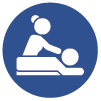When a person says ‘this pain is killing me’, it immediately communicates what a person is feeling. Hence, pain is not just a physical sensation, it is accommodated by an emotional response and an act of reasoning. Pain is a personal experience that has both physical and emotional effects. Suffering from one can be isolating and frustrating.
Pain is of two types; acute and chronic. Acute pain rarely becomes chronic. However, chronic pain can be persistent and lasts beyond normal healing time (more than three months). Your body is prone to pain. Acute pain warns us that something is not right within the body. Chronic pain, however, can deprive us of our daily life by interfering and making it hard to perform the most basic of tasks. Not only does pain has a physical consequence but also an emotional one as well leading to fatigue, irritability, depression, and failure to perform activities. By understanding the causes, symptoms, and treatments for pain, you can help yourself or anyone that might be experiencing it.
As previously mentioned, pain is difficult to explain, but your health professionals want to understand what you are experiencing so they can identify the exact reason and suggest a cure for your pain. Hence;
Patients need to understand their pain first
So, they can communicate it well to their health professionals
These health professionals will then select an effective treatment plan and monitor results accordingly.
Below, we provide a detailed article on the Patient’s Guide to Pain Management. This article will help you assist in an effective pain management assessment and the steps you can take to lessen your pain.
Purpose of pain assessment
Pain can be acute (predictable and short-lived response to trauma, surgery or an injury) or chronic, that can take longer to heal, typically more than 3 months. Pain assessment can help to;
- Diagnose and describe the experienced pain
- Monitor the pain to see whether the prescribed treatment is helping in improving or worsening.
- Understand the reason behind the pain to detect an effective treatment
In case if the diagnosed pain is acute pain, the treatment is short-lived and the pain resolves as the body heals. Chronic pain whereas lasts for a longer period of time, can be complex and require serious and long-term treatment. Chronic pain is often related to ongoing pathological processes such as osteoarthritis, or pains that are caused by damaging or misfunctioning of the nervous system. This includes pain as diverse as post-stroke pain to diabetic neuropathy.
Initial pain assessment will help your health professional a lot as it will help them understand why you are seeking treatment, what treatment has been already tried that was not as effective and understand your current condition.
Up to 23% of the population in the US faces chronic pain, and so it is likely that a patient suffering from acute pain may also be suffering from chronic pain.
Patient participation
Here, nurses and health professionals play an important role as to deeply assess a patient’s need. Some patients might not be as comfortable or expressive enough to communicate their pain properly or participate in discussions. Hence, health professionals need to consider this before choosing the most suitable strategy. Self-reporting or using a guided set of questions can be a suitable strategy. Using pain rating scales can be another option for patients who are not able to report pain verbally. They can simply point to communicate the intensity of their pain. There are various other options available as well.

In order to understand your pain correctly, your medical provider will ask you a set of questions that will help him figure out the right treatment for you. Asking yourself these questions can also be an effective way to figure out what kind of pain you might be experiencing. The most common questions are;
- Where exactly do you feel pain?
- How does your pain feel?
- Define the severity of your pain
- How often do you experience pain?
- Is there a certain time in a day when your pain is the worst? If yes, what time of day is your pain the worst?
- What gets your pain started?
- What makes your pain worse?
- Is there something that makes your pain better? If yes, then what is it?
- Does your pain come or go, or constantly stays?
- Does your pain make you sad, anxious, fearful?
- What do you think causes your pain?
- Does pain interfere in your ability to perform routine tasks such as getting dressed, eating, etc.?
- Have you used any medication in the past for your pain?
- What medications have you used in the past for your pain?
If you as a patient fail to communicate properly with your medical provider then your pain may take longer to heal. There are other tools that a health professional can use as well, such as he/she can ask you to rate your pain out of 10. No matter what method your healthcare professional uses, it still won’t be enough if you are not able to communicate it well. Below, we provide useful behavioral and physiological signs that can act as a signal that you or your loved ones are in pain.

Behavioral signs
- Crying, sobbing
- Position (curled, holding tightly)
- Facial expressions (tense, grimace)
- Restlessness
- Abnormal stillness

Physiological signs
- Increased breathing
- Increased heart rate
- Increased blood pressure
- Sweating
- Nausea
- Vomiting
Goals for care
Explain how you want your medical treatment to improve the functioning in everyday life
Information and answers to your questions about pain relief and pain
Have different treatment options to choose from
A quick response from your medical provider when you report pain
Pain is most often associated with an injury or disease, but it can also emerge slowly. This is true especially in the case of osteoarthritis or nerve disorders. When most of you are not able to identify an event that caused the pain, it can often lead to stress and anxiety. Asking questions and being more open about what you are experiencing can help your medical provider figure out the right treatment for you. Moreover, being open about your fears and discussing it out can help you cope up with anxiety, stress, and depression that comes with pain.

What is pain?
Pain can arise due to an injury, disease or damage to your body. It is an uncomfortable feeling and acts as a signal that there is something wrong. If you are suffering from pain, don’t ignore it and instead talk to your medical provider so he can prescribe you medicine or treatment for it.

Help yourself to manage pain
- Asking yourself about what is causing you pain and learning more about it can help you asses and relieve pain.
- Using the information gathered wisely is another way to ensure that you don’t prolong your pain and get medical help if necessary.
- Don’t hesitate to seek help in between follow-up visits.
- Staying active and healthy is another way to get rid of the pain.
It is important to act quickly if you want to avoid prolonging your pain. When you first experience pain, get treatment quickly in order to prevent it from getting worse. Being bedridden because of the pain can cause anxiety, fear, and depression that will only worsen your pain even more. It is important to know that pain is not something in your head or something you have to live with. Pain needs treatment and medical help.
A guide to managing your pain (self-help options)
There are options available to treat your pain without having to use pills.

Patient family education
Here, the person feeling pain along with their family is educated and taught about various tips and techniques to heal or treat pain.

Community support groups/educational plans
Patients learn about controlling their pain through the support of other patients dealing with the same thing. This is a great way to express and communicate your feelings and learning from others.

Exercise; yoga, walking, and others
Exercising is another great way to release and heal the pain. Yoga helps the body stretch and heal the pain as it consists of light movements. If practiced regularly, it can heal and prevent the body from many forms of suffering.

Heat
Placing a hot cloth or giving heat to the affected area can help in reducing pain. This is effective, especially for sore muscles and spasms.

Massage
Getting regular massage can be another great way to release the body of any tension or stress by relaxing it. It heals the body by breaking down muscle tension and pressure on nerves.

Ice
Just like heat can help reduce pain, so can ice. Putting ice on affected areas can help reduce pain and swelling. This is true especially for pain that is caused by joint problems or irritated nerves.

Relaxation through deep breathing and meditation
Deep breathing is another way to get your body in control and free it from any tension or stress.
Others
There are many other ways an individual can heal pain by themselves. Changing your attention or focusing on something else can help you take your mind off of the pain such as walking, reading or talking to someone close. Prayer provides relief from pain by giving comfort and support in times of illness or stress. Music improves mood and acts as a tension releaser. Listening to music can help in relieving pain.

If the pain still persists, it is obvious that it requires professional help. Getting medical help can help you get pain relief especially if it is chronic. Getting bedridden can be frustrating and lonely. Careful, consistent treatment can give a person a chance to connect with others and enjoy some quality in their lives. Most of the medical treatment revolves around the following;
- Medications (opioids and non-opioids)
- Interventional procedures
- Rehabilitative and occupational therapy
- Pain psychology
- Complementary alternative medicine
- Self-management

Opioids are considered an effective way to treat chronic pain. However, the risks associated with the use of this medication should be taken into account as there were a lot of cases of opioid addiction reported in US recently. Most people who are recommended this medicine are checked for any risk of developing an addiction. An opioid risk assessment tool can help in figuring out whether a patient should be given opioid treatment or not. It mainly consists of a questionnaire that asks a series of questions involving substance abuse, family history, and others.
The most important factor to determine correct pain assessment is the self-reporting and self-evaluation of the person experiencing the pain. Some patients are not able to communicate their pain effectively with their medical provider leading to misjudgments. In this case, a health professional plays an important role in figuring out the correct tool to use. Pain assessment can be difficult, especially in its initial stages however, a simple test of the severity can provide enough information for the most suitable treatment.


